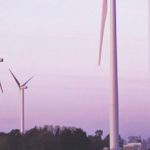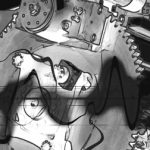As conventional energy sources—namely oil, gas, and coal—are increasingly limited in their respective quantities, many countries are encouraging the development of renewable energies. Wind energy, already a well-developed technology, is quickly becoming the most attractive renewable energy source. Cables used in the wind energy industry are facing challenges caused by the harsh environments where the wind can be harnessed most efficiently. The current status of the wind power industry is introduced herein, as well as the performance, requirements, and testing procedures of cables used in wind turbines.
Introduction
There has been increasing interest in renewable energy due to conventional energy resources being limited while demand still increases. Numerous types of renewable energy such as hydropower, wind power, solar power, geothermal power, tidal and ocean wave power, and biogas power have been emerging for decades. Although these renewable energies only cover a small portion of the entire energy demand, the promising future of these new energy sources is recognized globally.
In addition to the dwindling amounts of conventional energy sources, another factor accentuating the attractiveness of renewable energy is the pollution caused by fossil fuel power plants. As an alternative to fossil fuels wind energy is plentiful, renewable, widely distributed, clean, and produces no greenhouse gas emissions during operation. At the end of 2009 worldwide nameplate capacity of wind-powered generators was 159.2 GW[1]. Energy production was 340 TWh, which is approximately 2 percent of worldwide electricity usage [1][2] and has doubled in the past three years.
Regarding the existing wind turbine maintenance and new wind farm construction, engineers and designers meet the inevitable situation of having to choose the correct cable for such applications. For example, inside the wind turbine nacelle continuous flexing control and data cables should be used, while torsional flexing cable should be used within the wind turbine tower. In addition to the flexibility requirement thermal resistance, abrasion resistance, and resistance to oil and other chemicals should be considered. The complexity of cable selection could easily lead to a wrong decision and result in unnecessary downtime and costly maintenance.
Cable Requirements for Wind Applications
Wind farms are generally located in harsh environments with extreme weather conditions including high winds, ultraviolet light, and salt spray. Because of this the performance of the cables used in wind power applications is arguably more critical than that of other applications. The turbine’s moving parts also add to the already heightened importance of proper cable selection.
Premium-grade power cables, data and control cables, and communication cables need to be considered for existing wind farm maintenance and new, large-scale wind farm development to determine the interconnection quality for the power grid and communication system. The amount of cable needed for just one wind generator is not quite as minimal as one might imagine. For example, a 90m high 1.25MW wind generator requires approximately 1km power cable. As such, 40km cable would be considered necessary for a wind farm with 50MW capacity.
Wind generators work in tough environments that typically feature a wide temperature range (around -40º C to 50º C) and extremely large amounts of exposure to UV radiation. Therefore, the specified cable needs to be able to withstand -40º C and ultraviolet light for the desired longevity. For the moving parts of the wind turbine, the cable should have good torsional and bending flexibility with a small bend radius. The cable also needs to be resistant to fuel, coolant, oil, corrosive chemicals, and abrasion. Should the wind farm reside close to the ocean or offshore, the cable must also be saltwater resistant. In addition to the aforementioned requirements, flame retardancy is also required due to safety considerations. In certain cases extra features such as low smoke, zero halogen (LSZH) materials, and EMI protection may also be required. Taking all this into account, cable used in a wind power application should generally meet the following criteria.
Conductor: To maximize flexibility, it is recommended that design engineers specify annealed soft copper conductors with high strand counts, with a short concentric-lay construction for bending flexing applications and a long concentric-lay construction for torsion flexing applications. For conductors larger than 6mm2 (10 AWG), a rope-lay construction is required.
Insulation: To increase flexibility in low temperatures, thermoplastic elastomer (TPE), ethylene propylene rubber (EPR, a type of EPM or EPDM), or silicone rubber (SiR) are common choices for insulation material to resist ozone corrosion and aging due to heat. PVC/nylon insulation is also widely used due to its high dielectric strength.
Jacket: Cable jackets may be thermosetting compounds such as chlorinated polyethylene (CPE), polychloroprene (neoprene), chlorosulfonated polyethylene (CSPE) synthetic rubber (SR), or thermoplastic compounds such as TPE, TPE-PVC alloys, and polyurethane (TPU). These materials are oil-, fuel-, and solvent-resistant with superior flexibility under low temperatures. Such properties make them ideal jacket materials for wind power cables.
It should be noted that cable structure is also a considerable determinant the cable’s flexibility. Symmetric conductor design with a balanced structure will typically lead to a high degree of flexibility. Even if a cable is built following these general guidelines, full testing is strongly recommended to simulate the “real world” application.
Cable Test Method and Procedure
Depending on the direction of the wind, the turbine angle needs to be adjusted by the yaw drive. The power, control, and communication cables will either bend along the horizontal axis or rotate along the vertical axis. Torsional flexing is more severe and requires greater attention. Although currently there is no such standard or regulation for torsional flexing, end users typically prefer that the cables are tested by some means before being put into practice. The following is a common test method adopted by an end user in the cable industry.
Torsion stress test of a single cable under low temperature (-40º C): A 10m vertical suspended cable sample is fixed at top end; fasten the bottom end to a rotating mechanism. First, twist the cable clockwise four turns (+1440º) and then untwist counterclockwise four turns back to its original position. Next, twist the cable counterclockwise four turns (-1440º) and then untwist clockwise four turns back to its original position. Repeat this procedure for 5,000 complete cycles to simulate 20 years use. The cable shall pass the test if there is no breakdown under 2.5 U0 after five minutes and no cracks shown on jacket. Note: U0 is 600, 1000, or 2000 V according to the cable’s voltage rating. For torsion stress test of a bundle of cables the procedure is the same, but for a cable bundle.
Standards for Wind Power Cable
Currently no dedicated standard exists for cables in wind power applications. Many cable manufacturers follow IEC 60228 Class 5 or 6 (similar to DIN VDE 0295 Class 5 or 6, HD 383, GB/T 3956 Class 5 or 6) to use plain or metal-coated annealed stranded copper as the wind power cable conductor to achieve the needed flexibility. Interestingly, the IEC 60228 only specifies the nominal cross-sectional areas of the conductor and the number and size of wires in the conductor for electric power cables. This gives cable manufacturers a high degree of autonomy, often resulting in poor cable performance even though the cable meets the IEC 60228 Class 5 or 6 requirements. Conversely, UL 62—which refers to several ASTM standards—specifies not only the size and number of strands of the conductor, but also the conductor constructions such as concentric lay stranded, rope lay stranded, and bunch stranded conductor constructions which are all critical to the cable flexing characteristic.
For the insulation and jacket many manufacturers follow DIN VDE 0207-20 and DIN VDE 0207-21. HD 22.1, HD 22.4, UL 44, and UL 62 are also used as general standards for cable production. Other standards, such as UL 758, UL 1581, UL 1277, UL 2277, and IEC 60332, etc., are often used to support extra features like the Wind Turbine Tray Cable (WTTC) and flammability ratings.
As European countries began developing cables for the wind energy market before North America, many European standards are currently adopted by cable manufacturers. Nevertheless, UL standards as a counterpart show equivalent and, in some cases, tighter requirements pertaining to wind energy applications.
Successful Application
MLS Electrosystems is a global leader in the development, design, manufacture, distribution, and support of custom electric servo pitch systems for the wind turbine industry. MLS was created in 2000 when SIPCO Mechanical, R2J Technologies, and Matric came together and merged their market expertise and knowledge to focus on the servo control industry. MLS made many key improvements to the existing servo pitch control motor product line through a great deal of research and development. As a result, their design is now one of the best in the wind turbine industry.
MLS had been using plain wire for emergency power on a pitch servo motor located within the wind turbine. However, they were in need of a cable that could withstand temperatures as low as -40º C since the wire they were using was not holding up in the extreme environments that it was subjected to and were continually failing. As a complete solution, MLS chose Alpha Wire’s Xtra-Guard® 4 performance cable for its pitch servo motor. Not only does Xtra-Guard 4 withstand extremely high and low temperatures (-50° C to + 125° C), it is also known for its extremely high resistance to oils, chemicals, solvents, and fuels, all of which would benefit this outside application.
Conclusions
This technical paper introduces the current status of cable applications for the wind energy industry. The special requirements for wind power cables and their detailed construction and composition are summarized. A commonly recognized test method for cable torsional flexibility is also introduced. It is suggested by the authors that the cable construction and test data should be evaluated prior to selecting the cable for any existing wind farm maintenance and future wind energy facility constructions.
References:
1) “World Wind Energy Report 2009,” World Wind Energy Association. February 2010.
2) “Wind Power Increase in 2008 Exceeds 10-year Average Growth Rate,” Worldwatch.org.







































